Recently I've been seeing more and more new driving schools appear in my area advertising cheap driving lessons with a variety of special deals. Offers such as '10 lessons for £99', '5 hours for £55' and '4 hours for £44' are appearing with increasing regularity. But is the customer really getting value for money? Personally I know that I could never operate my driving school offering such deals - it would barely cover my overheads - and I wouldn't want my business associated with anything 'cheap' anyway - so how are other driving schools achieving it?
Are you getting value for money?
Now I obviously can't speak about every driving school out there offering these deals but from the many stories I've heard the general answer is NO for a variety of reasons:
- Sitting on the side of the road for most of the lesson. I often hear tales from pupils who have come to me from other driving schools that they would spend most of their lessons parked up in the car going over theory rather than getting in valuable practical work. This is a way that driving schools can cut costs - less fuel used and less wear and tear on their car. I once heard a story that a driving school in the area carried out a 2 hour highway code lesson with their pupils!
- Tying on from the first point, less practical work on lessons is going to result in a decreased progress in the pupils driving skills. If you're sitting about for half of every lesson not actually driving then it's going to take you twice as long to get to test standard. So that '10 lessons for £99' deal looks good on the surface, but if it's going to take you double the lessons it would at a established and reputable driving school is it really a decent saving?
- The initial offer will only be a one off and can include some terms and conditions. Once you've had your deal, the lesson price will go back to the driving school's standard prices. The terms and conditions on a '10 hours for £99' for example can typically be something like 3 hours to be held back for test day lesson. That would tie you to the driving school - you get your first 7 hours and then MUST stay with the driving school until your test to get the other 3 hours - something you might not want to do if you're not happy with the instruction being given to you.
James decides he wants to go for cheap driving lessons. He finds a random company online doing a '10 hours for £99' deal. However, due to the driving schools ways of cutting costs it takes James 50 hours to pass. The final 40 hours were also at the standard price of £200 for 10 hours. Also James wasn't particularly happy with his instructor but 3 hours was reserved for his test day so he didn't want to lose that. In total James had to pay £899 compared to John who paid £630. Also John managed it in around 4 months compared to James who took 7 months due to the extra lessons.
These cheap deals can look too good to be true and often are so beware. I think it's much better to choose a school on reputation, testimonials and recommendations rather than price - there's probably a good reason why one school can charge a lot more than another - you generally get what you pay for in this life!!
Please visit jodythomasdriving.co.uk for a reputable driving school that you can trust


.jpg)





.jpg)

.jpg)
.jpg)
.jpg)






